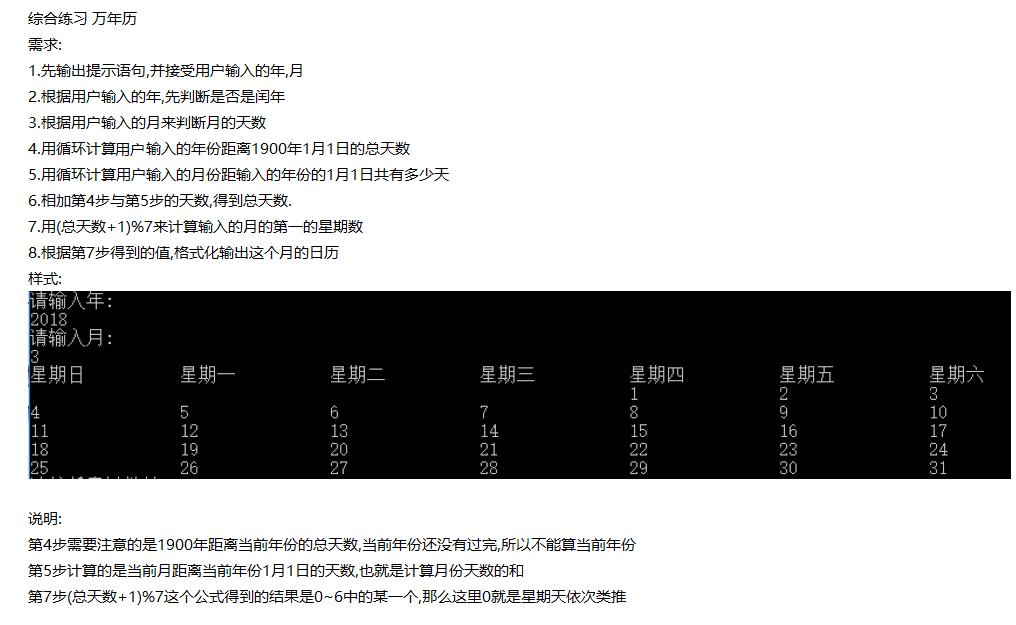使用方法去完成 import scala.io.StdIn object work1 { def main(args: Array[String]): Unit = { // 1.先輸出提示語句,並接受用戶輸入的年,月 println("請輸入年:") var year = StdIn.readIn ...

使用方法去完成
import scala.io.StdIn
object work1 {
def main(args: Array[String]): Unit = {
// 1.先輸出提示語句,並接受用戶輸入的年,月
println("請輸入年:")
var year = StdIn.readInt()
println("請輸入月:")
var month = StdIn.readInt()
// 2.根據用戶輸入的年,先判斷是否是閏年
def reiNian(nian: Int): Boolean = {
if (nian % 400 == 0) {
return true
}
if (nian % 4 == 0 && nian % 100 != 0) {
return true
} else false
}
// 3.根據用戶輸入的月來判斷月的天數
def getNowMonthDays(year: Int, month: Int): Int = {
if (month == 4 || month == 6 || month == 9 || month == 11) {
return 30
} else if (month == 4) {
return if (reiNian(year)) 29 else 28;
} else return 31
}
// 4.用迴圈計算用戶輸入的年份距離1900年1月1日的總天數
def getFormNowYearTo1900TotalDays(year: Int): Int = {
var sumdayyear = 0
for (i <- 1900 to year) {
sumdayyear = sumdayyear + (if (reiNian(year)) 366 else 365)
}
return sumdayyear
}
// 5.用迴圈計算用戶輸入的月份距輸入的年份的1月1日共有多少天
def getNowYearToDays(year: Int, month: Int): Int = {
var sumday = 0
for (i <- 1 to month) {
sumday = sumday + getNowMonthDays(year, i)
}
return sumday
}
// 6.相加第4步與第5步的天數,得到總天數.
var totalDaysY = getFormNowYearTo1900TotalDays(year);
var totalDaysM = getNowYearToDays(year, month);
var totalDays = totalDaysY + totalDaysM
// 7.用(總天數+ 1)%7來計算輸入的月的第一的星期數
def getweek(totalDays: Int): Int = {
return (totalDays + 1) % 7
}
// 8.根據第7步得到的值格式化輸出這個月的日曆
def FormatCalendar(week: Int, year: Int, month: Int): Unit = {
var cut = 0; //記數 判斷是否是到7 如果到7就換行
println("星期日\t\t星期一\t\t星期二\t\t星期三\t\t星期四\t\t星期五\t\t星期六")
//星期數的列印
for (i <- 1 to week) {
print("\t\t")
cut = cut + 1
}
//列印月份對應天數
for (i <- 1 to getNowMonthDays(year, month)) {
//列印值
print(i + "\t\t");
cut = cut + 1
if (cut % 7 == 0) {
println()
}
}
}
FormatCalendar(getweek(totalDays), year, month)
}
}
使用函數去完成
import scala.io.StdIn
object work2 {
def main(args: Array[String]): Unit = {
// 1.先輸出提示語句,並接受用戶輸入的年,月
println("請輸入年:")
var year = StdIn.readInt()
println("請輸入月:")
var month = StdIn.readInt()
// 2.根據用戶輸入的年,先判斷是否是閏年
val reiNian=(year:Int)=> {
if (year % 400 == 0) {
true
}
if (year % 4 == 0 && year % 100 != 0) {
true
} else false
}
// 3.根據用戶輸入的月來判斷月的天數
val getNowMonthDays=(year: Int, month: Int) =>{
if (month == 4 || month == 6 || month == 9 || month == 11) {
30
} else if (month == 4) {
if (reiNian(year)) 29 else 28
} else 31
}
// 4.用迴圈計算用戶輸入的年份距離1900年1月1日的總天數
val getFormNowYearTo1900TotalDays=(year: Int)=>{
var sumdayyear:Int =0
for (i <- 1900 to year) {
sumdayyear = sumdayyear + (if (reiNian(year)) 366 else 365)
}
println(sumdayyear)
sumdayyear
}
println("****")
// 5.用迴圈計算用戶輸入的月份距輸入的年份的1月1日共有多少天
val getNowYearToDays=(year:Int,month:Int)=> {
var sumdaymonth:Int= 0
for (i <- 1 to month) {
sumdaymonth = sumdaymonth + getNowMonthDays(year, i)
}
println("****")
println(sumdaymonth)
sumdaymonth
}
// 6.相加第4步與第5步的天數,得到總天數.
var totalDaysY:Int = getFormNowYearTo1900TotalDays(year)
var totalDaysM:Int = getNowYearToDays(year, month)
var totalDays = totalDaysY + totalDaysM
// 7.用(總天數+ 1)%7來計算輸入的月的第一的星期數
val getweek=(totalDays: Int)=> {
(totalDays + 1) % 7
}
// 8.根據第7步得到的值格式化輸出這個月的日曆
val FormatCalendar=(week: Int, year: Int, month: Int) => {
var cut = 0; //記數 判斷是否是到7 如果到7就換行
println("星期日\t星期一\t星期二\t星期三\t星期四\t星期五\t星期六")
//星期數的列印
for (i <- 1 to week) {
print("\t\t")
cut = cut + 1
}
//列印月份對應天數
for (i <- 1 to getNowMonthDays(year, month)) {
//列印值
print(i + "\t\t");
cut = cut + 1
if (cut % 7 == 0) {
println()
}
}
}
FormatCalendar(getweek(totalDays), year, month)
}
}



